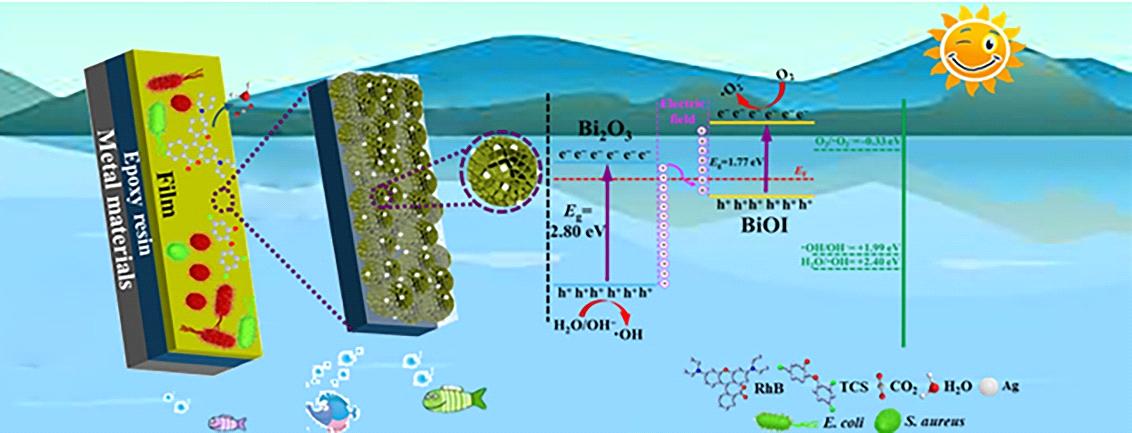Various photocatalyst powders (such as bismuth oxide/bismuth oxyiodide) can remove contaminants and microorganism from waterbody efficiently, but their practical application was limited due to poor recovery performance.
Previous studies used magnetron sputtering and electrodeposition to obtain the bismuth-containing seed layer for bismuth-based photocatalytic film hydrothermal in-situ grown onto the various substrates. However, magnetron sputtering and electrodeposition were sophisticated and energy-consuming, whether was there the equivalent and simple media layer that substitutes bismuth seed layer.
Recently, the research team led by Prof. ZHANG Dun from the Institute of Oceanology of the Chinese Academy of Sciences (IOCAS) provided a kind of novel epoxy resin mediate layer for hydrothermal in-situ grown photocatalyst onto various metals.
The study was published in Separation and Purification Technology on Mar. 15.
Researchers found that the photocatalytic film with similar flower-like morphology can grow onto epoxy resin coated metals including 316 stainless steel sheets, 304 stainless steel cylinders and meshes, Cu, Al, and Ti alloy sheets. Epoxy resin intermediate layer exhibited a distinguishing functionality of this work that was unconstrained selectivity to metal substrates.
Researchers thought the dipole-dipole interactions between amid group of the stabilizer polyvinyl pyrrolidone (PVP) and epoxide group of epoxy resin were conductive to form the photocatalytic film of hydrothermal in-situ grown active sites. Dissolution-recrystallization process occurred at the edge of the newly formed nano-sheets. The nano-sheets were continuously stacked and assembled, a flower-like microsphere film was gradually formed layer upon layer on metals.
In this study, the film exhibited good photocatalytic activity and cyclic stability on photodegrading antibiotics and sterilizing microorganism possessed. In addition, the study found that the morphology of the films can be tailored by adjusting the amount of PVP and reaction time.
"By contrasting with powdered bismuth-based photocatalyst, the film showed similar photocatalytic activity, indicating that the transformation from powdered photocatalytic to film can maintain good photocatalytic activity, this method can improve the utilization of powdered photocatalyst," said XU Xuelei, first author of the study.
"By inducing epoxy resin as the media layer that substitutes bismuth seed layer is simple and convenient, this method doesn't need sophisticated facilities. This work provided the valuable prospects for the fabrication of recycled photocatalyst, and can also be adopted to prepare other films for photocatalytic application," said Prof. ZHANG.
"The film composed of N, P-doped heterostructure may also have potential value for removing contaminants and microorganism. Therefore, this work highlights the development of convenient, economical, recycled and universal photocatalytic film on various metals for contaminants degradation and microorganism killing for human healthy," said Prof. WANG Yi, the corresponding author.
This research was supported by National Natural Science Foundation of China, and High-end Users Program of "Kexue".

The scheme of metals/epoxy resin/Ag decorated Bi2O3/BiOI photocatalytic film used as an easily recycled photocatalyst
Xu, X., Wang, Y., Zhang, D. (2022). A Novel Strategy of Hydrothermal In-Situ Grown Bismuth Based Film on Epoxy Resin as Recyclable Photocatalyst for Photodegrading Antibiotics and Sterilizing Microorganism. Separation and Purification Technology.
WANG Yi
Institute of Oceanology
E-mail: Wangyi@qdio.ac.cn
(Editor: ZHANG Yiyi)
|
|

Address: 7 Nanhai Road, Qingdao, Shandong 266071, China
Tel: 86-532-82898902 Fax: 86-532-82898612 E-mail: iocas@qdio.ac.cn


